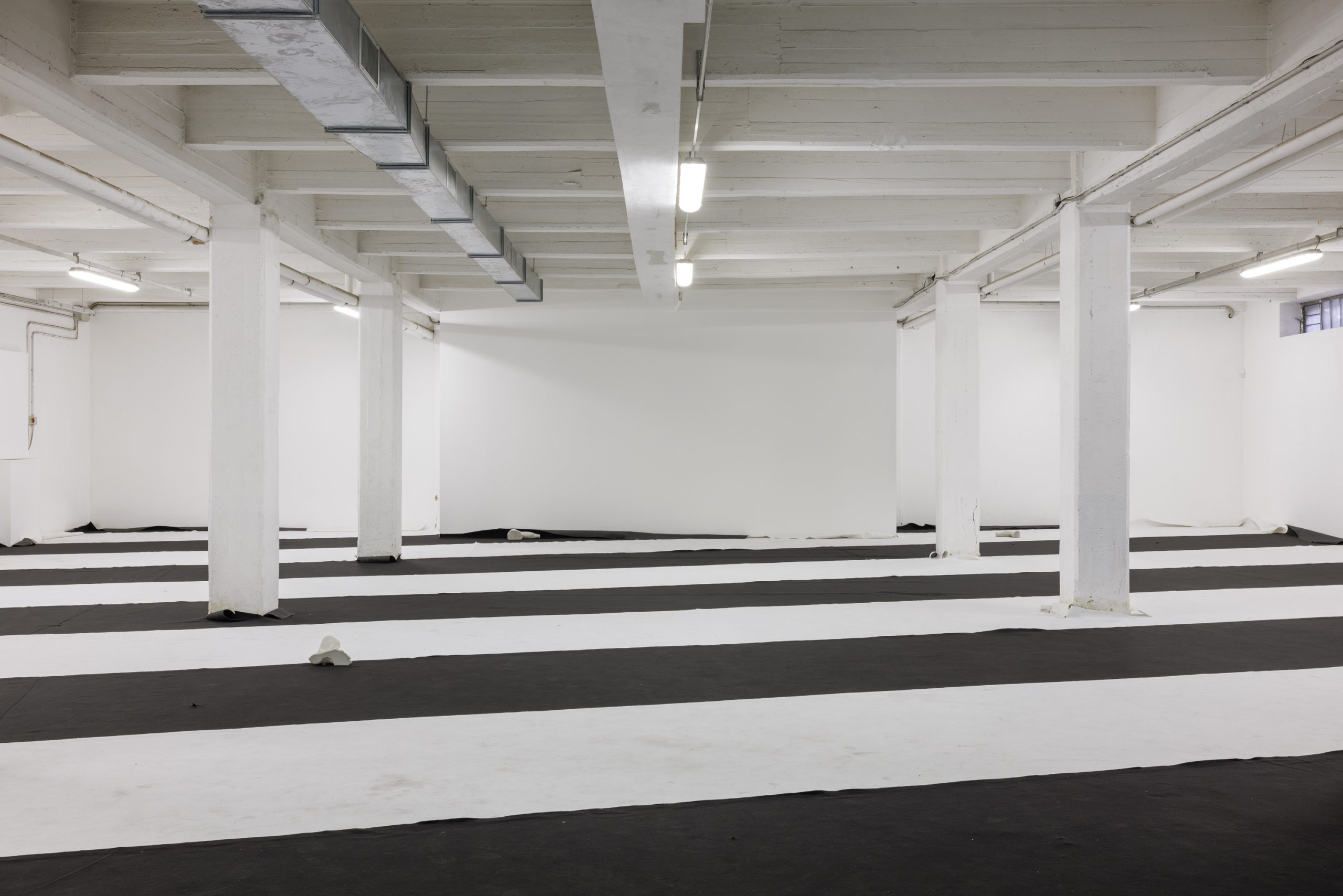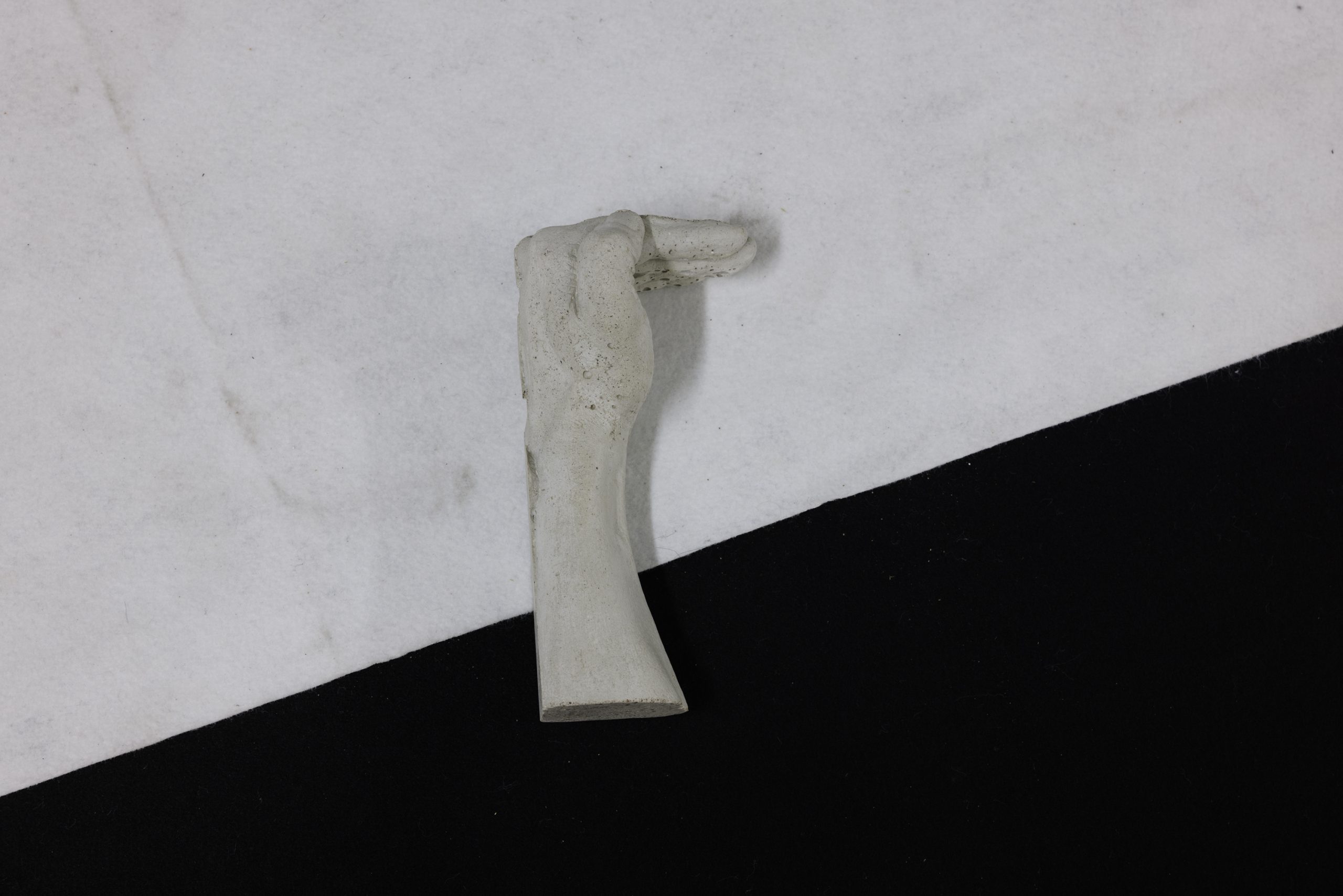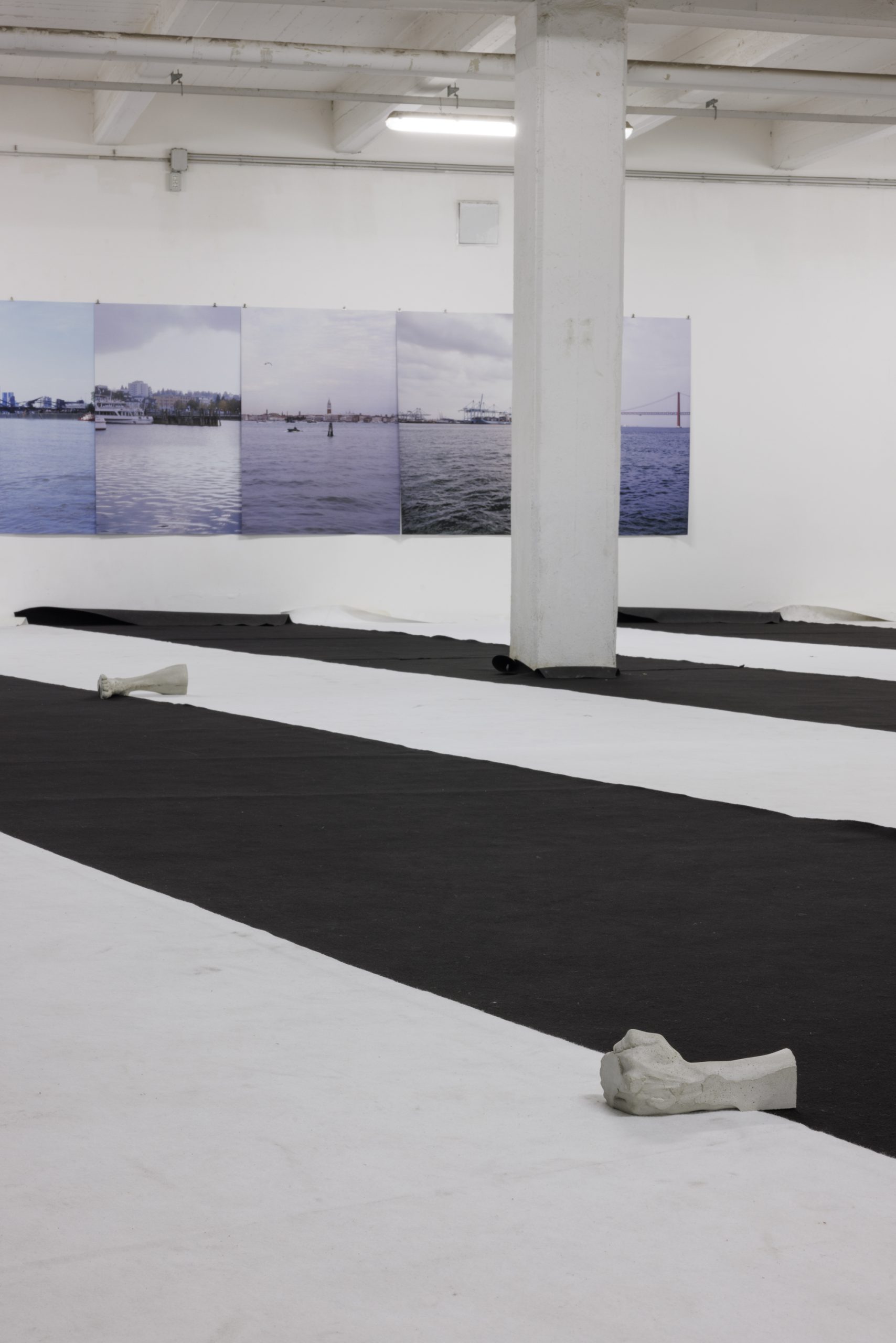The way towards Galleria ZERO… is guided by a slender neon sign reminiscent of an unknown hotel at the end of a courtyard. In these Spring days, the streets are silent, bordered by warehouses and low buildings, forming a shifting urban landscape. This gallery boasts two decades of exhibition experience, formerly located at via Tadino until 2014. The three dots following the name hint at an unknown inclination towards the future, as if softly murmuring about onward journeys. ZERO… gallery resonates as a receptive space, an enclave keenly attuned to global artistic currents, perpetually echoing whispers from across continents. Its presence unfolds leisurely, shunning haste in media appearances. The founder Paolo Zani welcomes us with a smile, eager to share some insights on the show, which is on view until June 22nd, 2024.
We find ourselves in Porto di Mare, the southern Milan area, a place meant to be a genuine port, at the border of Corvetto, plans for a river traffic port were conceived in late 1917 to replace the Darsena of Porta Ticinese. However, this endeavour was never completed, and today no seagulls flying over these shores.
Porto di Mare is Hans Schabus’ exhibition recently inaugurated here at ZERO… together with Micol Assaël’s Dusty Landscapes exhibition installed on the upper floor of the gallery. Two exhibitions and two artists in dialogue–a physical and metaphorical descent and ascent from the sea to the transparency of dust, bridging two analogous energies. The artists live in unison the delicate moment of mid-career a moment of deceleration and introspection on practices and conceptual approaches. A transformative opportunity, at times a potential curse, for those navigating the creative world, which is by nature hybrid, changeable, and stormy: an unstable balance in the pursuit of artistic consolidation. ZERO… too, with them, serenely traverses this intermediate phase, a moment of metamorphosis for a mid-career gallery attentive to new generations, now dedicated to renewal and growth.
We descend the stairs, entering beneath the earth’s surface. Here, we immerse ourselves completely in Schabus’ work, an imposing site-specific installation shaping the underground architecture of ZERO… with its motion and a faint scent of mould and fabric. A monumentally sorrowful, melancholic, and deeply moving project. The entire floor is covered with strips of white and black fabric, which resembles a vast carpet roughly cut on the edges as if they were waves of a stormy sea crashing onto the shore. The presentation of the carpet itself carries the inherent sound of fluid waves, a dynamic non-place on the verge of drowning: A Troubled Water. Traces of a wild party are still evident on the carpet: wine stains, signs of struggle, clashes, footprints, and dirty shoes. Originally part of a spatial concept for the 125th Secession anniversary in 2023 at the Secession Vienna museum, the carpet now speaks in silence, echoing the space’s reverberation, accompanied by a strong stormy rumble. There’s a noise, a smell: there’s a story.
Behind, a cheap poster-sized print shows Schabus on a small boat navigating Vienna’s labyrinthine sewers, a reverse journey documented through photographs and the video Western (2002), commissioned by Engholm Engelhorn Galerie, Vienna. The original goal was to reach New York, but how? Schabus glides through Vienna’s sewer system on an Optimist, a single-handed sailing boat for novice sailors and children, a varnished piece of craftsmanship he named Forlorn. Schabus’ story begins with this boat rowing through murky waters and cavernous tunnels, leaving the invisible city, from the old to the new world, in his words. Dressed in an Austrian lumberjack checkered shirt, the artist embarks on a kind of heroic metaphorical journey, midway through the journey of our life. Schabus specifically references Orson Welles’s film ‘The Third Man’ (1949). While observing, references to Korean and Japanese cinema such as ‘The Host’, ‘Oldboy’, and the spiritual ambiance of Kim Ki-Duk with his pragmatic absences, or ‘Castaway on the Moon’, come to mind. There’s a sense of security provided by invisibility, a game of pursuer and pursued. A romantic voyage into the uncertain darkness of the underground, a childlike excursion as an escape and a non-arrival, perhaps, leaving behind the known world and unnecessary collected things.
Six images printed on cheap advertising poster paper, titled Disappearance between Walls and Waters, depict six locations and six bridges navigated by the artist on the Optimist: New York, Frankfurt Manifesta, the Kunsthalle in Bergen, Venice during the Biennale, Rotterdam and San Francisco. Flipping the hanging images, we discover Schabus’ figure on the boat folded, hidden, and pushed against the wall. The artist erases himself and disappears in the suspension of this delicate middle period, living between the water’s surface and the wall of a geographically distant space flattened, awaiting something, freeing himself from the image and the responsibility it entails, disappearing towards new routes.
In the space, four concrete sculptural elements cast parts of Schabus’ body, that metaphorically outline the four corners of his studio in Vienna. Born a woodworker, Schabus embodies the classic idea of an artist in his studio, pushing himself to the limit of his mental and physical strength to materialize an obsession. His work always exhibits a strong spatial character, addressing a specific reflection on the space he works in, escaping and sneaking through back alleys, even constructing them himself: an artwork within the structure, literally digging into his urgent history. Schabus seeks to bridge places and geographical distances, deconstructing the compact inaccessibility of the city and the kilometers that separate the physical from memories. In Porto di Mare, the artist reflects on the manifestations of his wild, primitive instinct, never self-referential but always connected to history, society, and historical occurrences. Within these walls, in this very moment, exhibiting is a pursuit of escape.
As we ascend the stairs from the gallery’s ground floor, we encounter Micol Assaël’s Dusty Landscapes. The artist lives and works between Rome and Greece, investigating the relationship between the body and invisible elements like air, electricity, the immaterial, sound, and nature’s forces. Dusty Landscapes draws explicit inspiration from Japanese philosophy and spirituality. In the space, old windows, doors, and rusted architectural elements, recovered from a disused space in Turin, are arranged and on their dusty glass, illuminated by spotlights, Japanese ideograms are written with fingers: ’emptiness, ‘dynamism,’ ‘reverberation,’ ‘sound,’ ‘depth,’ ‘disorder,’ ‘darkness.’ Each ideogram speaks of harmony and linearity, legible through an elegant interplay of reflection and translucency. The dust settled on the glass was intentionally and manually collected by two assistants from the gallery, chosen by Assaël as her apprentices, traveling through Milan to collect the dust of the world and stage it in the gallery: a process echoing ancient Greek philosophers’ practices. We speak of ‘dèbris’, a term indicating the philosophical and spiritual meaning of a ‘fragment’, a remnant of the past, collected with diligence and meticulousness. Dust doesn’t carry an ecological connotation: it’s the result of natural processual entropy, a residue of something destroyed, decomposed, or disintegrated from an existential perspective. The works embrace something new under the sun, materializing in the form of forgetfulness and abstract gestures. Thus, a dual reference of the abandoned object -a fragment of a ‘before’ world – and writing, a human practice born to combat the forgetfulness of the mind. Micol captures in the ephemeral instability of dust a complex of citations, a metaphor for temporal levels intersecting, leaving behind the pale image of those who have contemplated them at least once or for a moment.
Positioned beneath the artworks are fine copper wires, a material extensively examined in Assaël’s practice as a superconductor of electricity. Black and white photos of the gallery itself are positioned in the space from the perspective from which we see the architecture, affirming the narrative of the display. The relationship between the object’s agency and ideograms doesn’t remain a metaphorical intuition but reveals a non-ontological analogy concerning the complex of knowledge and discourses crystallizing around things: History is deposited in the two times of the gesture. In evocative and melancholic minimalism, Assaël shows consonances and convergences with ancient reflection, dating back to Heraclitus, philosopher of flux, or Anaximander, who postulates the ‘apeiron’, meaning the ‘indefinite’. Light and shadow multiply meanings, reconnecting them to the faceless and identity-less gesture, drawing them in the dust of the world around.
In her extensive career, the artist reconstructs zones of interaction: intense, transformative works often conveying psychological and physical discomfort, bridging science and philosophy. Through technical equipment–power generators, vintage engines, static and dynamic forces, electrical circuits, and powerful air conveyors–she engages with scientific and natural phenomena, reconstructing non-human environments, almost in a menacing, perhaps dangerous dystopia. Over the years, she has worked with sound, flashes, high and low temperatures, electric shocks, and electromagnetism, narrating energetic charge and the tension binding man to the earth, art to its shadow. Micol’s works depart from conceptual art and minimalist sculpture, probing the body and how the liberation of ideas and energy occurs, as if the body were to belong to no one, like an experiment conducted in the neutral, objective setting of a laboratory; or in a meditative exercise, leading to sensory deprivation and mental freedom within the flow of events. Dusty Landscapes communicates through a mental state, a play of dust and soft light, not putting us at risk but tapping into our exposed nerve, our most vulnerable memories, evoking a ghost from whose intensity we fled long ago.
Two artists and two dramatic and poignant exhibitions narrate us a calculated risk to rediscover, silently, the essence of travel, to forsake one’s perspective and certainty. and embrace uncertainty: an essential risk to defining our limits. The destination, here at ZERO…, is a mere pretext.





